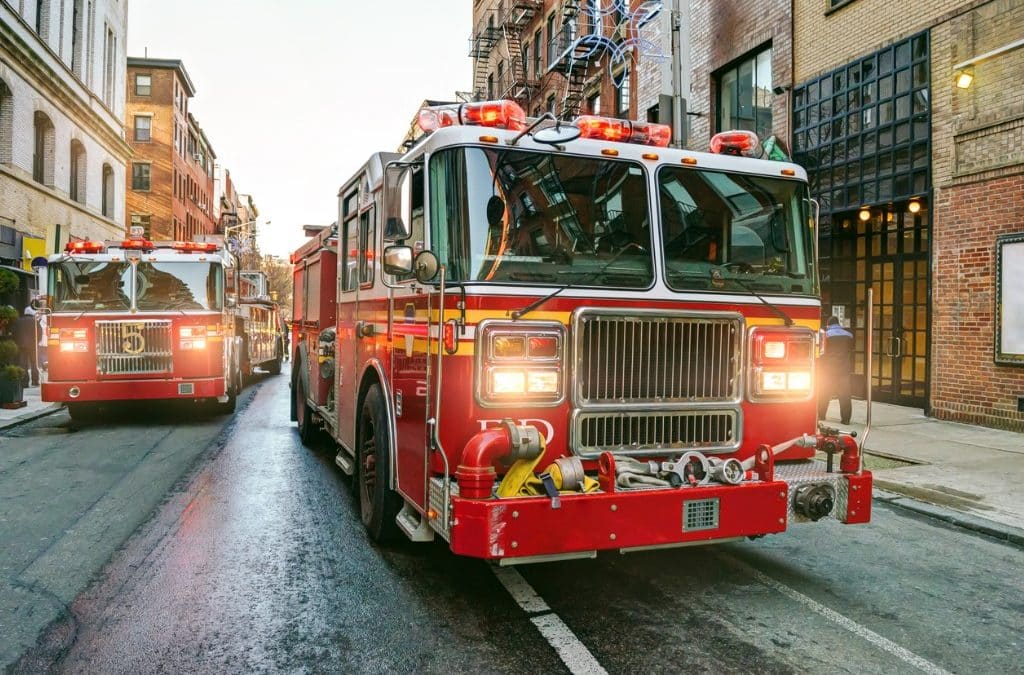As the first people to arrive on the scene of an emergency, first responders need to be able to rely on their vehicles. Whether they are stationed in a rural area, a quiet suburb, or a busy city, the emergency management vehicles that they drive need to be upfitted with features and technology that help them effectively handle any emergency situations that they may encounter.
Law enforcement vehicles need to be equipped with radar systems, surveillance cameras, and a designated prisoner transport area; fire service vehicles need to be upfitted with the firefighting and protective equipment that is required to effectively handle a flame; ambulances and emergency service vehicles need the proper medical equipment. A lack of reliable vehicles puts public safety in jeopardy.
At TCS Upfitting, our team can upfit emergency response vehicles with all manner of upgrades and features to help first responders be better equipped to handle emergency situations. The following upgrades are some of the most important ones to consider when upfitting an emergency response vehicle.
Light Bars
Advanced lighting systems are a staple of emergency vehicles and are absolutely necessary for warning other drivers to pull over to the side of the road. LED light bars are typically what are used to create those telltale flashing lights, signifying that an emergency vehicle is approaching.
Oftentimes, light bars have multiple programmable settings, so that, with just the press of a button, the lights can be set to a different color to warn people of different situations. They are particularly effective at night, so that people can see an emergency vehicle coming, especially if they are moving fast.
Contrary to popular belief, emergency vehicle lights have to be brighter during the day and dimmer at night. This is because they are more difficult to see during the day. TCS’s light bars are equipped with a photocell that automatically dims the lights at night and brightens them during the day.
Sirens and Speakers
Sirens go hand in hand with flashing lights to alert drivers that an emergency vehicle is nearby and is in a hurry. They are a useful warning to people who can’t see the lights or if the emergency vehicle is coming up from behind them.
Speakers come in handy if the driver needs to convey a message to another vehicle or if they need to communicate with a large group of pedestrians. Whether they are telling another vehicle to pull over, warning a group of people to move out of the way, or giving important information, a built-in speaker system can help with this task.
Most upfitters utilize 100 watt sirens, but, at TCS Upfitting, we only use 200 watt sirens. Traffic can be noisy, and, if people are blaring their music in their cars, it can be difficult to hear approaching sirens. Our 200 watt sirens make it much easier for the public to hear oncoming emergency vehicles.
Graphics
One of the simplest forms of vehicle upfitting is probably not even considered by most people to be an upgrade. Nonetheless, emergency vehicle graphic designs are absolutely essential. Without the stylistic design choices, unique colorations, a caduceus, or the words ‘fire department’ or ‘police department’ in large print, what exactly is telling you that you are driving near an emergency vehicle?
These emergency vehicle graphics are considered to be passive visual warning systems, as, even though the vehicle may not have its lights or sirens blaring, the driver is still a first responder, and he or she may have to leap into action at a moment’s notice.
Communication Equipment
It is very important that first responders are able to communicate with one another, otherwise critical information to the situation may not be conveyed to the people that need it. In addition, without proper communication equipment, first responders won’t know whether or not a particular emergency is already being addressed by another person or group. A lack of communication can put first responders at risk or cause them to arrive at a situation later than they should have.
Computers and Monitors
Police department vehicles and mobile command centers are decked out with state-of-the-art equipment and for good reason. In order to properly deal with a particular situation, first responders, police officers, and medical professionals need a constant stream of information. Whether it is looking up an individual in a criminal database, assessing a person’s past health issues, or receiving directions to the scene of an emergency, a built-in computer and a mounted monitor are crucial pieces of equipment for any emergency vehicle.
Video Surveillance and Camera Systems
Unfortunately, things can and will go wrong during emergency situations. It is impossible for EMTs, firefighters, and police officers to be prepared for every single eventuality. Situations can get out of control, and people make mistakes. This is why it is important to have vehicles fitted with video surveillance cameras.
If a shooting breaks out, a vehicle collision happens, or some other incident occurs, having the entire situation on video can help people who weren’t there determine what exactly happened and what measures need to be taken.
Weapon Vaults and Storage for Other Equipment
Needless to say, emergency situations can sometimes call for drastic measures, and, while law enforcement officers typically carry a personal firearm on them at all times, police, SWAT, and command vehicles need to have a supply of other weapons and tools in case the job calls for them. These can include shotguns, rifles, batons, bolt cutters, first aid kits, or body armor. Most of this equipment needs to be kept in a secure location so that it is not easily accessible to just anyone.
Push Bumpers
Push bumpers are additions to the front, backs, and sides of emergency vehicles that provide extra protection against vehicle collisions and other heavy impacts. They can also be used to move disabled vehicles off the road.
Prisoner Transportation Seating and Partitions
In the case of law enforcement vehicles, it is necessary to have space to accommodate an apprehended suspect or anyone else who has been arrested and is being taken to jail. This means adequate space in the backseat, doors that cannot be unlocked from the inside, partitions to separate the front from the back seats, and reinforced or barred windows to prevent escape attempts.
Most prisoner transport systems are not airbag-compliant. Without airbags for the prisoners in the back, this can lead to legal troubles and lawsuits if the emergency vehicle is involved in a car accident. At TCS Upfitting, our prisoner transport systems are fitted with airbags to ensure maximum safety and minimum risk of lawsuits.
Partner with TCS for Your Vehicle Upfitting Needs!
These are only some of the most common upfits for emergency vehicles, but there are several more available as well. The team here at TCS Upfitting has extensive experience upfitting both the outside and inside of vehicles.
We can customize a wide variety of vehicle types, including trucks, ATVs, UTVs, golf carts, and, of course, emergency vehicles. TCS is truly a “custom upfitter,” as we will go anywhere and perform any upgrade on your vehicles.


